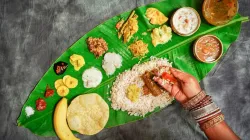Banana to Lotus: 5 types of LEAVES used for serving food and their surprising benefits
Know the versatility of leaves used for serving food, from banana to lotus. These natural alternatives not only impart unique flavours but also offer surprising health benefits like antioxidant properties, antimicrobial effects, and environmental sustainability.

In various culinary traditions around the world, leaves have been used for centuries not just as serving vessels but also for their unique benefits that enhance the flavour and nutrition of foods. Whether it's the aromatic lotus leaf in Chinese cuisine or the nutritious bitterleaf in West African dishes, leaves continue to play a vital role in enriching global gastronomy. From banana to lotus, here are five types of leaves commonly used for serving food along with their surprising benefits:
1. Banana Leaves
Banana leaves are widely used in South and Southeast Asian cuisines for serving food, especially during festive occasions and ceremonies. These large, flexible leaves impart a subtle, earthy flavour to the food they wrap. Surprisingly, banana leaves are also known for their antibacterial properties, which help in keeping food fresh and hygienic.
2. Grape Leaves
Grape leaves, particularly in Mediterranean and Middle Eastern cuisines, are used to wrap foods like dolmas (stuffed grape leaves) and to cover dishes during cooking to enhance flavour. Grape leaves are rich in vitamins A, C, and K, as well as flavonoids and polyphenols. They are known for their potential anti-cancer properties and their ability to support heart health.
3. Palm Leaves
Palm leaves are commonly used in South Indian and Latin American cuisines for serving food like rice, tamales, and desserts. These leaves are sturdy and impart a subtle grassy flavour to the food. Palm leaves are environmentally friendly as they are biodegradable and sustainable. They also contain antioxidants and are believed to have anti-inflammatory properties.
4. Lotus Leaves
In Chinese cuisine, lotus leaves are favoured for their large size and their ability to impart a unique fragrance to the food they wrap. They are often used to steam rice and other dishes, adding a delicate herbal aroma. Lotus leaves are rich in antioxidants and have been traditionally used in Chinese medicine to promote digestive health and detoxification.
5. Bitterleaf (Vernonia amygdalina)
Bitterleaf is widely used in West African cuisine, particularly in Nigeria, where it is known as ewuro or onugbu. The leaves have a slightly bitter taste and are used in soups and stews. Bitterleaf is highly nutritious, containing vitamins A, C, and E, as well as minerals like calcium and potassium. It is valued for its digestive benefits and potential to regulate blood sugar levels.
Benefits of Using Leaves for Serving Food
- Natural Flavour Enhancement: Leaves impart unique flavours and aromas to foods, enhancing the overall dining experience.
- Health Benefits: Many leaves used for serving food are rich in antioxidants, vitamins, and minerals, offering various health benefits such as improved digestion, immune support, and anti-inflammatory properties.
- Environmental Sustainability: Using leaves as food wrappers reduces plastic waste and supports sustainable practices in food service.
ALSO READ: Boost your morning with these 5 nutritious millet recipes for a healthy breakfast